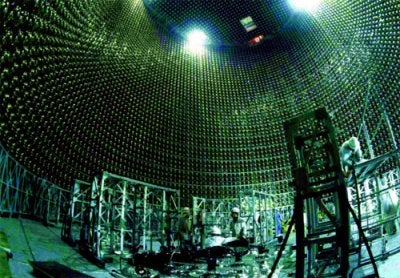United Kingdom particle physicists working on the multinational Tokai-to-Kamioka (T2K) project, which is designed to detect some of the least understood particles in the universe, have helped track the first neutrino that has traveled 185 miles (295 km) under Japan. The detection of the neutrino as it passed from the East to the West of the country means the study of the mysterious phenomenon of neutrino oscillations, which it is hoped will shed more light on the role of the neutrino in the early universe, can now begin. It could even help answer questions about why there is more matter than anti-matter in the universe.
T2K, an international experiment led by Japan and partly funded by the United Kingdom’s Science and Technology Facilities Council (STFC), was built to help us understand more about the strange properties of the puzzling neutrino.
“Neutrinos are the elusive ghosts of particle physics,” T2K spokesperson Takashi Kobayashi said. “They come in three types, called electron neutrinos, muon neutrinos, and tau neutrinos, which used to be thought to be unchanging. This is a big step forward, and we’ve been working hard for more than 10 years to make this happen.”
T2K’s newly constructed neutrino beamline at the J-PARC facility in Tokai village (north of Tokyo) will start to try to take measurements of the so-far unobserved neutrino oscillation, which would cause a small fraction of the muon neutrinos produced there to become electron neutrinos by the time they reach the giant Super-Kamiokande underground detector on the other side of Japan.
“Observing the new type of oscillation would open up the prospect of comparing the oscillations of neutrinos and anti-neutrinos, which many theorists believe may be related to one of the great mysteries in fundamental physics — why is there more matter than anti-matter in the universe,” said Dave Wark of Imperial College London and STFC’s Rutherford Appleton Laboratory. “The observation of this first neutrino means that the hunt has just begun!”
Interacting only weakly with matter, neutrinos can traverse the entire Earth with vastly less loss of intensity than light passing through a window. The very weakness of their interactions allows physicists to make what should be very accurate predictions of their behavior.
“The first measurements of the flux of neutrinos coming from the thermonuclear reactions which power our Sun came as something of a shock because they were far lower than predicted,” said Wark.
Super-Kamiokande demonstrated a second anomaly when it showed that the flux of different types of neutrino generated within our atmosphere by cosmic ray interactions was different depending on whether the neutrinos were coming from above or below — which should not have been possible given our understanding of particle physics. Other experiments, such as KamLAND (also performed at Kamioka), the Canadian-American-United Kingdom Sudbury Neutrino Observatory (SNO) experiment, and the STFC-supported Main Injector Neutrino Oscillation Search (MINOS) experiment have conclusively demonstrated that these anomalies are caused by neutrino oscillations, whereby one type of neutrino turns into another.
United Kingdom scientists from nine institutions, who are among the 508 physicists from the 12 countries involved, have made a significant contribution to the experiment, producing vital hardware for both the accelerator and detectors. The United Kingdom is also playing a leading role in the analysis software for the experiment, and they will be fully involved in using the data to explore the properties of neutrinos.
“STFC is proud to be funding an experiment that could make such a significant contribution to our understanding of these elusive particles and, indeed, to what we know about the formation of the universe,” said John Womersley, director of science programs at STFC.
The first initial science results from this experiment are expected within a few months, but it will be several years before any definitive answers are found.










